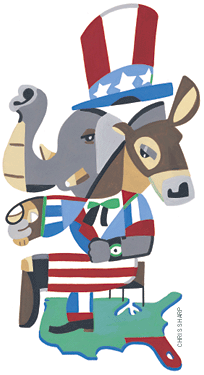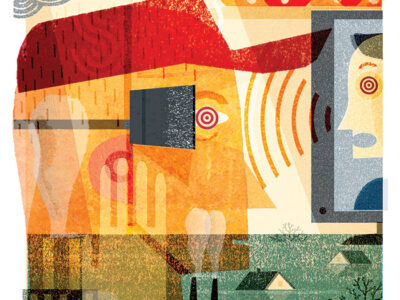
As any political junkie knows, there’s room for argument after every election—though not usually about who won. Not, that is, until last year.
The 2000 presidential campaign and its unique aftermath were the focus of two recent campus forums—an invitation-only election “debriefing” hosted by the Annenberg Public Policy Center (APPC) and a panel discussion on The New York Times’ coverage of the Florida recount battle, both moderated by Dr. Kathleen Hall Jamieson, dean of the Annenberg School for Communication and director of the APPC.
The purpose of the APPC conference—which featured campaign analyses by Bush and Gore advisers, pollsters, advertising consultants, and members of the media—was to develop an accurate picture of the election before public perceptions get “locked in,” noted Jamieson in her introduction. (An edited videotape of the proceedings will be available for schools to use in classes.)
Matthew Dowd, campaign director of polling and media planning for the Bush camp, emphasized that from the start, that campaign had taken a general-election strategy, comparing it to the National Hockey League playoffs, which many regard as “the real season.” Though temporarily derailed by John McCain’s “Straight Talk Express” in the early primaries, the plan was successfully carried through to November.
Gore, Dowd suggested, sometimes “reinforced negatives” about his own character, including a tendency to exaggerate and a willingness to say anything to get elected. (Dowd pointed to Gore’s about-face during the Elián Gonzalez controversy and to his proposal to tap into the Strategic Petroleum Reserve when oil prices rose in the summer of 2000.) He also cited Gore’s propensity to lecture, which was particularly evident in the first debate. Ironically, the debates turned out to be a major turning point in Bush’s favor, he said—a notion that campaign staffers “would have laughed at” early in the campaign.
Asked about Gore’s popular-vote victory, Dowd credited Democratic turnout efforts with core groups—blacks, union households, Hispanics—that “exceeded expectations,” while the overall number of conservative voters was down. Also, late-deciders, who traditionally favor the challenger, broke for Gore instead.
Fred Steeper, who worked on market strategies and research for the Bush campaign, talked about some hot-button issues to which the two campaigns responded differently, including social security and gun control. Even some opponents gave Bush credit for touching the “third rail” of American politics by including privatization in his social-security reform proposals —but according to Steeper, campaign polling showed that as much as 80 percent of Americans favored investing some portion, and even 40 percent of the over-64 age group favored it when the proposal was couched in the campaign’s reassuring phrasing, such as “bipartisan … choice … every penny … no cuts.” Similarly, with gun control, responses varied depending on how questions were framed.
When it was time for Gore campaign officials Carter Eskew and Bob Shrum to speak, Shrum joked that they had “hoped to be here under different circumstances.” But the humor was only on the surface. In their view, Shrum said simply, “Gore won.”
Rather than squandering what should have been a runaway victory, Shrum added, Gore in fact overcame substantial disadvantages—including the Clinton scandals and the “shadow of the vice presidency”—to amass the greatest number of votes for any Democratic candidate in history and create the model for a new center-left Democratic coalition.
Gore matched Clinton in attracting suburban voters, and surpassed him among African-American and labor voters—despite a third-party challenge from the left in the person of Ralph Nader.
Contrary to conventional wisdom, Shrum said, the campaign’s analysis showed that it was not possible for Gore to simply run on the Clinton record. Instead, they expanded the message of building on the administration’s economic success to “extending prosperity to all”—which had the added advantage of being the message that Al Gore wanted to deliver. The campaign’s plan was to give a fuller dimension to Gore and have him emerge from the “shadow of the vice-presidency,” while raising doubts about Bush’s record in Texas.
The Democratic convention provided a “bounce” that was “real and profound,” Eskew said, and polls showed that it bolstered Gore’s image in terms of leadership and character, providing a “strength that was buffeted in the campaign but never left us.” As the election approached, the campaign resisted “tremendous pressure” to spend money in California, making a “bold decision” to concentrate on Florida. The campaign closed strongly in the last two weeks, campaigning only in tight states and visiting those at least twice. In the end, the undecideds broke for Gore, and to the surprise of almost everyone, he won the popular vote.
So, what went wrong? For Eskew and Shrum, the main problem was that the campaign ended in a recount state where the president’s brother was the governor, and the election was ultimately decided by a Supreme Court with ties to the Republican nominee. Those details aside, they noted that the Gore campaign came out of the primaries “flat and unfocused,” while Bush managed to repair damage from his primary challenger and rebuild his lead. Gore didn’t recover momentum until after the convention, allowing Bush to recreate the sense of “invincibility” with opinion-makers. (Shrum recalled a national correspondent telling him, “Bob, it’s really sad; you’re just crazy,” when he insisted that Gore would win.)
Also, with Gore having the clear “message advantage,” Shrum said, Bush “did something smart,” blurring the differences on issues like education, health care, and social security rather than simply ceding them to the Democrats.
Bush “jumped over a very low hurdle in the debates,” Shrum added. “We lost the expectations game—I’m not sure we could have won it.” The Bush campaign succeeded in framing discussion of the first debate in terms of Gore’s “misstatements,” and while the second debate was a bore, it “allowed Bush to jump a low bar on foreign policy.” Gore did win the third debate, helping to raise doubts about Bush and leading voters to “worry, ‘Is Bush up to the job?’”
Shrum conceded that the “Clinton factor” became an obsession for voters and the press “that we never figured out.” He and Eskew both insisted that the problem was not so much between Gore and Clinton or within the campaign as a question of “when to use” Clinton externally. Had it not been for the “climate of scandal,” Shrum argued, Gore would have won decisively.
According to Stan Greenberg, the Gore campaign’s pollster, “The lesson is not that the Democrats lost the election.” In fact, he noted, when the Nader vote is added to Gore’s popular-vote victory, the center-left coalition carried 52 percent of the vote. And when the core message of the Gore campaign is stacked up against the Bush campaign’s—meaning the candidates’ positions divorced from values/leadership issues—the Democrats led by a hefty 54 percent to 37 percent. That, said Greenberg, is important for “where we go from here.”
The two camps were united on one issue: the television networks’ election-night coverage. Republicans charged that the early call of Florida for Gore had suppressed voting in the Florida panhandle, where polls were still open, while the Democrats claimed that the reversal of that call two hours later and the 2:00 a.m. call of the state for Bush created a public perception that if anyone should drop out of the race, it should be Gore.
Most of the audience agreed. “Why are you not reporting the results rather than making calls? This policy is wrong, and it has to be changed,” Curtis Gans of the Committee for the Study of the American Electorate demanded of the lone network representative, Kathy Frankovic, director of surveys for CBS News.
Frankovic, who is also a board member of the Voter News Service (VNS), the polling organization whose faulty information was used by all the networks to predict the election results, gamely defended her industry. While admitting that mistakes were certainly made (and detailing several of them), she countered that the election had exposed numerous flaws in the U.S. electoral system, not just television’s coverage of it. Frankovic fixed the blame on the electoral system of different poll-closing times, noting that CBS has supported uniform poll-closing times since 1964. But others at the conference dismissed the idea as unrealistic in a nation with multiple time zones.
A few weeks later, B. Drummond Ayres, Jr., a national correspondent for The New York Times, called the election “a disaster waiting to happen,” in which polling and balloting irregularities that go unnoticed in more lopsided elections were exposed. He also decried the increased “hyping of election nights,” noting that while polling is not going to stop, the question of when to release results has to be addressed: “Pollsters and journalists must do something to fix this, or Congress will.”
Ayres and Times reporter Somini Sengupta were on campus to participate in a Provost’s Spotlight Series in connection with 36 Days: The 2000 Presidential Election Crisis, a new book from the Times. (Dean Jamieson, who served as moderator, noted wryly that crisis was a word the Times studiously avoided during the actual events.)
Ayres and Sengupta—who reported from Volusia County and Tallahassee and wrote a profile of Katherine Harris for the paper—defended the Times’ coverage, at times contrasting it with that of other newspapers as well as the TV networks. Ayres voiced outrage at the personal attacks on Florida Secretary of State Katherine Harris, calling them “absolutely unacceptable, terrible stuff.”
Sengupta asserted that reporters do their best to keep biases out of their stories, adding that some seemingly biased perceptions arise from the candidate’s own strategies—such as the Bush campaign protesters in Florida, with their ubiquitous Sore Loserman posters.
“The Bush strategy was to create a sense of chaos,” she said, while “the Gore strategy was not to have a street presence—until late in the game. Keep chaos at a minimum and promote a sense of orderliness, methodicalness.” This backfired to some extent, in that Bush’s supporters seemed both more numerous and more passionate about their candidate’s victory than Gore’s did.
While Ayres called the election a “bad thing, a bad trauma” that is still being felt, one member of the audience accused the Times of ignoring voices of opposition in the days after President Bush’s inauguration.
“We must cover the feel-good meetings with Bush and Democrats,” replied Sengupta. “Those who did not sit down—that could also be news, but there’s a limit to the stories [we can do] on people who don’t buy that this man is president.”




